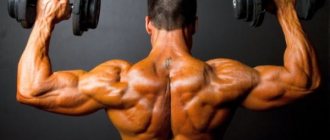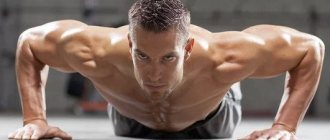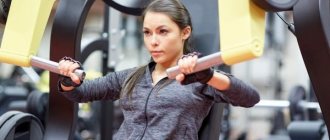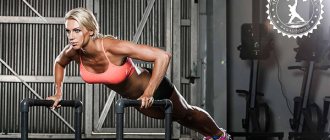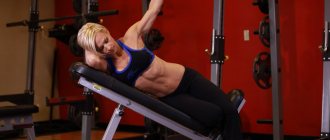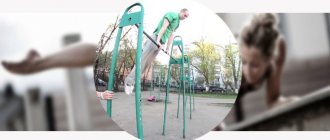Why do you need to pump your arms?
Yes, in fact, it is not necessary and not particularly necessary to pump them up :), because they make up 5-7% of all muscle volumes of the body, so theoretically they cannot give any significant increase in weight.
Often, many training programs, for example, for ectomorphs, completely exclude this muscle group or devote the least time to it. Of course, the hands are involved in almost all movements and receive their load indirectly, but still it cannot be compared with targeted and highly specialized work. Therefore, you need to shake your hands, at least for this reason:
- As various surveys show, ladies pay significant attention to their hands. In muscular arms they feel the strength and ability to protect and not allow them to be offended;
- pumped up arms look good in summer in various sleeveless T-shirts - this is a sign of good physical shape of their owner;
- when you are asked to show your pumped up muscles, you always show your biceps;
- in the men's world, volume matters, so if you have weak hands, then the attitude towards you is appropriate;
- strong hands are the ability to resist holds/choke and deliver a crushing blow to an opponent;
- for women, toned arms and strong forearms/hands are a plus in everyday life, such as carrying bags or carrying a child;
- for women - this is the absence of jelly and various sagging under the arms;
- If you have muscle-toned arms, you can afford sleeveless and open-shoulder dresses.
Anatomical atlas of arm muscles
The arm muscles have many large, externally visible muscles that help us in everyday activities, such as changing clothes or using a PC.
The muscles of the upper limbs are divided into:
- shoulder muscles, which in turn are divided into the anterior group (flexors) - brachialis, coracobrachialis, biceps and posterior (extensors) - ulna, triceps;
- The muscles of the forearm are the largest, these are the brachialis (brachialis) and brachioradialis (brachiradialis).
From the point of view of occurrence, it is customary to distinguish:
- superficial (clearly visible on the surface) – biceps, triceps, brachyradialis, long extensor carpi radialis, deltoids;
- deep muscles - lie deep on the surface.
The muscles of the upper arm are responsible for flexion/extension of the forearm at the elbow joint. Flexion of the forearm is achieved by a group of three muscles - the brachialis, biceps and brachyradialis.
In general, in the literature on anatomy it is not customary to translate the names of muscle groups, i.e. there, for the preservation of the original Latin names, for example, brachialis will be musculus brachialis. In this regard, a more correct “Latin anatomical picture” of the arm muscles will look like this.
Let's look at the major large muscle units individually.
No. 1. Biceps
The large, thick fusiform brachii muscle is located on the upper part of the humerus, consisting of 2 heads - long and short. Both originate in the shoulder area, attach below to the round eminence of the forearm bone, and unite in the middle of the shoulder.
The biceps performs the following functions:
- works as a forearm supinator by turning and moving the palm upward;
- flexes forearm/shoulder;
- flexes the upper arm (raising the arm forward and up).
No. 2. Triceps
The triceps fusiform muscle lies on the back of the shoulder. It has three heads - lateral, medial and long, which merge on the olecranon of the ulna. The lateral and medial heads of the triceps originate on the humerus, the long head begins on the scapula.
The triceps performs the following functions:
- extends the elbow joint/helps straighten the arm - acts as an extensor of the forearm at the elbow joint and humerus at the shoulder;
- The long head also assists the latissimus dorsi during the bench pullover exercise, bringing the arm down toward the body.
Summarizing the “head” muscles, the combined anatomical picture of biceps + triceps looks like this.
No. 3. Forearm muscles
The most famous and largest muscles of the wrist are: brachialis, brachyradialis, flexor carpi radialis longus and coracoid muscles. Let's look at them in more detail.
3.1. Brachialis
Most of the muscles that move the wrist, arm and fingers are found in the forearm - they are thin, like a strap. The brachialis is a flat, fusiform muscle that lies under the biceps on the lower anterior surface of the shoulder. The beginning is attached to the bottom of the humerus, and the “end” is attached to the bony eminence of the forearm.
Brachialis performs the following functions:
- the main and strongest ulnar flexor - responsible for bending the elbow in any position of the hand (supination, pronation, neutral).
3.2. Brachyradialis
This is a fusiform muscle located on the front surface of the forearm. Originates at the lower outer part of the shoulder, crosses the elbow and extends to the radius (outer lower part). To see the muscle, tense your forearm and move your thumb to the side; the brachiralis will “appear” near the elbow, closer to the biceps tendon.
The brachioradialis muscle performs the following functions:
- bends the elbow;
- plays an active role in the up/down rotation of the forearm.
3.3. Extensor carpi radialis longus
On the back of the arm are extensor muscles such as extensor carpi ulnaris and extensor digitorum longus, which act as antagonistic flexors. The extensors are somewhat weaker than the flexors.
The extensor carpi radialis longus muscle is located next to the brachyradialis and is one of the 5 major muscles that help move the wrist. When a person clenches a fist, this muscle is actively involved and protrudes from the skin.
3.4. Coracobrachialis muscle
A long, narrow, beak-shaped muscle located on the inner surface of the shoulder. At the top it is attached near the coracoid process of the scapula, and at the bottom - to the front inner part of the arm. This muscle is not an elbow flexor
The coracobrachialis muscle performs the following functions:
- bringing the arm toward the body with the elbow bent.
A composite atlas of all the muscles of the forearms looks like this.
Actually, we're done with anatomy. Friends, are you still here...or am I just shaking the air? :). Let's go further and now talk about practical training aspects.
Supination and pronation - what is it?
These are two special movements produced by the muscles of the forearms - supination (turning outward) and pronation (turning inward). Supination is produced by the biceps and the muscles of the round supinator of the forearms, pronation - by the muscles of the pronator teres of the forearms.
It turns out that different grips on equipment (for example, dumbbells) provide different types of work for the arms and different degrees of participation of the biceps/triceps and forearms muscles.
Chin pull
How to make your shoulders wider? The answer is simple - do deadlifts. As a rule, most beginning athletes neglect this exercise, making a huge mistake. For bodybuilders, this is one of the most useful exercises, because it wonderfully develops shoulder width. You already know that the deltoids consist of 3 beams, but many athletes, as a rule, are only interested in the middle beam, which gives that same width. This is what they are trying to develop as much as possible, “killing” it with countless approaches. Since each of the fascicles performs its own work (the front and part of the middle fascicle perform pressing functions, and the other part of the middle and rear fascicles perform traction functions), uneven development of the shoulders is often observed, where the dominant position is occupied by the anterior delta, followed by the “backward” middle and back. What conclusion can be drawn? If you want really broad shoulders (the photo below shows them), you need to do deadlifts.
One of the best exercises is the chin row. It is much more effective than standard swings, because you can lift heavy weights and reduce the risk of injury to a minimum. In general, each of the above exercises is useful in its own way. All you need is to build the right training program that will give you impressive results. And all “jocks” need them, because narrow hips, broad shoulders and voluminous arms are the standard of the male body.
How to pump up deltoids on the horizontal bar?
In general, pull-ups are not a specialized exercise for developing deltoid muscles. The deltoids act here as “auxiliary” muscles. However, all types of pull-ups allow you to include them in your work.
One of the functions of the anterior delta is shoulder flexion, that is, raising the arm in front of you until it is parallel to the floor. At approximately the midpoint of the lift, when pulling up, the shoulders are parallel to the floor, which means that the deltoids are under tension.
More effective in terms of stress on the anterior deltoid muscles of the shoulders are pull-ups with a straight medium grip and partial pull-ups.
- Pull-up with a medium straight grip Starting position – hanging, bending at the back. Your legs need to be bent at the knees and crossed. As you pull yourself up, you simultaneously bring your shoulder blades together. At the highest point of the lift, we touch the bar of the horizontal bar with the top of our chest. When descending, we straighten our arms almost completely to give a good stretch to the back muscles.
- Partial pull-up with a medium reverse grip. Performed from the same starting position as the first exercise. The pull-up does not occur to the maximum point, but to the middle of the amplitude. At this point you need to fix the body and bend the forearms, trying to bring the collarbones as close as possible to the crossbar. The delta experiences the greatest tension precisely while holding the body in the middle of the lift, when the forearms are parallel to the floor. This exercise also works great on the biceps of the shoulders. To get the load on the rear deltoids, pull yourself up with a narrow reverse grip.
- Pull-up with a narrow reverse grip. The starting position, as usual, is hanging, bending over. Pulling yourself up, we bring your shoulder blades together and move your shoulders back, while trying to touch the horizontal bar with your lower chest, directing your gaze to your hands.
However, powerful shoulders cannot be imagined without well-developed trapezius muscles.
Dumbbell swings
Dumbbell swings allow you to “target” your deltoids. In the first months of training, most beginners cannot perform this exercise correctly, although in essence it is one of the most effective ways to “finish off” the deltoids after heavy basic exercises. In the hall you can see 3 options for performing swings:
- front;
- average;
- rear
Raising dumbbells in front of you best develops the front deltoids. As a rule, performing this exercise is not necessary, since the front beam works with all types of rows and presses. If you still want to make this part of the delta larger, then using small weights in parallel with a large number of repetitions will be the best option for such training.
The middle beam is best loaded with swings from the sides. However, remember: firstly, it is advisable to lower your shoulders down in order to exclude the trapezoid from the work. Secondly, tilt your body slightly forward, making the exercise easier. Third, try to keep your elbows slightly higher than your wrists as you move.
Finally, to pump up the back bun, perform the exercise in a similar way to the previous option, but bend lower forward.
How to pump up a trapezoid?
For the trapezoid, pull-ups are just one of the main exercises. As we already know, the emphasis on working the back muscles, in particular the trapezius, is done by wide-grip pull-ups. There are two types of them - pull-ups to the chest and behind the head.
- Wide grip pull-up to chest. Starting position – hanging, arched at the back, legs bent at the knees and crossed. The grip width is the same as for a wide bench press. When performing, we try not to strain the biceps and lift using the back muscles, while bringing the shoulder blades together. When lifting, you need to strive for the contact of the upper chest with the horizontal bar and direct your gaze to the top. The elbows in this exercise should “look” clearly at the floor.
- Pull-up with a wide grip behind the head. In this pull-up, unlike others, the legs are straightened in line with the body, there is no deflection in the back. At the top of the lift, the bar should be behind your head. To avoid injury, be extremely careful about your head position. Be sure to keep your elbows pointed straight at the floor.
In addition to the trapezius muscles, wide-grip pull-ups also involve the teres dorsi muscles.
When answering the question of how to pump up your shoulders on the horizontal bar, it is not enough to simply list the types of pull-ups that develop the shoulder muscles. The effectiveness of these exercises very much depends on the correctness of their implementation.
Therefore, your first goal is to learn how to do pull-ups correctly.
Correct pull-up is:
- smooth rise due to muscle strength, not a jerk;
- smooth descent, equal in time to ascent;
- lack of inertia and body swaying;
- lifting to the point where the chin is above the bar;
- strong grip and vertical position of the body;
- correct breathing (ascent - exhale, descent - inhale).
Grip methods
The horizontal bar is also attractive because it allows you to put a load on different muscles of the shoulder girdle, just by changing the method and width of the grip.
There are three ways to grip a pull-up:
- overhand or straight grip;
- underhand or reverse grip;
- neutral grip (palms facing each other and body perpendicular to the bar).
In terms of width, there are narrow (narrower than the shoulders), medium (shoulder-width apart) and wide (as in a bench press with a wide grip) grips.
By narrowing the grip, we transfer the main load to the arms, while expanding it, to the back. Knowing this pattern will help you choose types of pull-ups depending on your goals.
Does this mean dumbbell swings are useless?
Not really. At an advanced level of training, swings allow you to more specifically pump up one or another part of the delta, which noticeably lags behind others. Despite this, in other aspects they are significantly inferior to deadlifts and presses on several counts. Firstly, when performing an isolated exercise, we expose ourselves to great danger due to the complex structure of our shoulder joints. Secondly, it practically does not give the muscles additional strength and volume. For these reasons, a more effective training would be to initially perform heavy basic exercises, after which you can simply “finish them off” with swings.
Rules for organizing training
Equally important is a competent approach to organizing your training. After all, we achieve not just muscle strength and tone, but also their growth. Therefore, the second goal is to build the training correctly. To do this, the following conditions must be met:
- Train regularly – 2-3 days a week and be sure to rest between workouts. Muscle growth does not occur during the training itself, but after it - during the recovery period. Working hard will deprive your muscles of this period, and, consequently, of growth. If the muscles are very sore, it means they have received a lot of microtraumas, so you still won’t get full results from them - it’s better to give them another day of rest.
- Do the optimal number of repetitions and approaches (sets). For muscles to grow, you need to do 3-4 sets, each with 8-12 repetitions. We approach the maximum number of repetitions in a set gradually: first we do as many as we can, and then over time we increase the number of repetitions.
- Rest between sets for 2 minutes.
- Increase the load. The muscles adapt to the load and no longer receive stress, which stimulates the growth and development of muscle fiber. Therefore, over time, we gradually increase the number of repetitions and sets. If this load is not enough, you can use weights, for example, doing pull-ups with a heavy backpack over your shoulders or wearing a belt on which weights are hung from a barbell. But, the greater the weight, the fewer repetitions you need to do (but not less than 6).
- Concentrate on the work of the muscles that we are “pumping”.
- Provide the body with proteins - muscles need protein not only for growth, but also for normal recovery.
- Watch your technique for performing pull-ups. By violating the execution technique, you reduce the effect of the exercises and risk injury.
The described shoulder exercises on the horizontal bar are just the “mandatory minimum”. If you add all other types of pull-ups to it, it will only be better, because in this case the shoulders will always be involved, albeit with varying degrees of load.
Which is better: presses or swings?
How to pump up broad shoulders? Of course, you need regular training and adherence to the regime. However, which exercises should you focus more on? Now let's try to explain.
To develop truly voluminous deltoids, you need to do heavy basic exercises, because these are the ones that make it possible to use the principle of load progression. Of course, such exercises primarily include all kinds of presses. If we talk about swings with dumbbells, then they, of course, more “targetedly” load your shoulders, but the lack of significant progression in weights does not allow you to gain muscle mass and strength. However, light exercises allow you to “clog” your muscles at the end of the workout, and therefore it would be foolish to neglect the swings. Finally, we should not forget about the fact that there is a direct relationship between training weights in basic and isolation exercises. This means that if you can handle heavier weights in compound movements, you will also be able to handle heavier weights in isolation movements. Although in the opposite case this is impossible.
Features of nutrition when playing sports
With a very active lifestyle, the body needs a special sports diet that will help it cope with stress. Therefore, be sure to follow certain rules:
- The number of calories received with food should be 15% more than those burned during exercise. So, the average person needs at least 1800 kcal per day to play sports. If this requirement is not met, the body will begin to make up for their deficiency at the expense of muscles. Over time this will lead to exhaustion.
- Include high protein foods in your menu. This is especially true for men who seek to increase muscle mass. Protein is known to be a building material for our muscles. The daily protein intake is calculated based on the ratio: 1 – 2.5 grams per 1 kilogram of weight. Products with a high proportion of protein include beans, peas, soybeans, nuts, sunflower and pumpkin seeds, and dried fruits.
- Carbohydrate-containing foods play an important role for the body. To play sports in the gym, a person needs a supply of energy. And its source is carbohydrates. They also perform a transport function, supplying the required amount of protein to muscle tissue. High quality pasta, rice, oatmeal, buckwheat, vegetables and fruits, flour and confectionery products are considered reliable sources of carbohydrates. However, excessive consumption of such foods can lead to obesity. Therefore, you need to know when to stop everything.
- The cause of extra pounds can be fats that enter the body with food. However, they cannot be completely abandoned. The fact is that their deficiency can lead to serious hormonal imbalances. Nutritionists recommend reducing their quantity and replacing animal fats with vegetable fats. Consume in olive and flaxseed oil, hazelnuts, walnuts, almonds, peanuts, and avocados.
